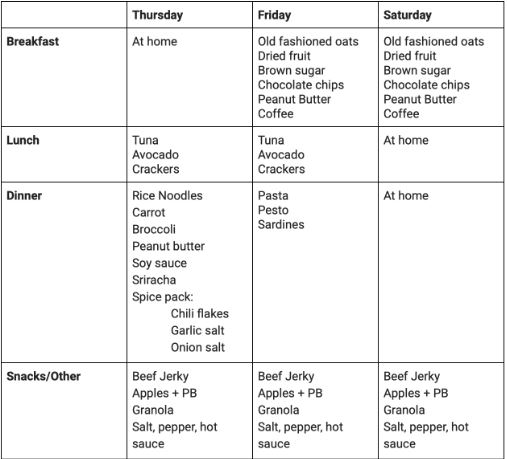
by Lindsey Segal
Backpacking is a great way to get outside, get some exercise, and avoid crowds during COVID-19. It’s also an approachable outdoor activity for novices, plus the fundamental backcountry skills you’ll learn will serve you well in more technical outdoor pursuits (or power outages, or pandemics). Here are the basics:
- Decide where you want to go
- I chose Los Padres National Forest because 1) it’s very pretty 2) it’s not too far from home (no additional stops !) and 3) National Forests have fewer restrictions than State/National Parks right now
- Decide on your route and itinerary
- Look at AllTrails, the Hiking Project, or a book; ask a friend for recommendations; or pull out a map and connect trails until you get your desired mileage!
- I got my route from my friend Sarah and the Pomona Outing Club:

- Double check your itinerary with some of the resources you didn’t use to plan it and call the ranger station
- This is super important!! Don’t skip this step!! For example, I thought this loop was 11 miles and it was really 19!!
- Call the ranger station to ask about pertinent information like trail closures, snow conditions, stream crossings, and seasonal information
- Make sure to check the weather as well
- Obtain permits
-
- Find out what permits are necessary and make sure you have all that you need. Permits are annoying but they help keep our wild areas wild and are very important. It is also illegal to backpack without a permit in many areas.
-
- Plan your meals
-
-
- Look at our blog for more meal ideas, but here are some general tips:
- Each meal should be around 600 calories
- Rolled oats + toppings are a great breakfast and much more nutritional and almost as easy as packaged oats
- Lunch can be anything easy that you don’t need to cook
- You can make anything in the backcountry you can make at home!
- Snacks are important!!
- Here’s my meal plan:
-
-
- Make a risk management plan
-
- Think through all of the dangerous situations that could happen and how you would deal with those
- Know the phone numbers of the ranger station, closest hospital, and local authorities and know evacuation routes and how to get to the closest hospital
- Make sure at least one other person knows your itinerary and when you are expected to return
- Examples:
- Dehydration: bring at least 2 litres of water and a gravity filter plus aquamira as backup water purification
- Injuries: bring properly stocked first aid kit and minimize risky behaviour
-
- Gather equipment
- Do this a couple days in advance so you have time to get anything you don’t have
- Here is a sample packing list:
-
-
-
-
-
-
-
- Food
- Backpack
- Sleeping bag
- Sleeping mat
- Tent or tarp
- Hammock (optional)
- Headlamp
- Stove & fuel & lighter
- Pots n pans (only bring what you’ll need for your meals)
- Personal utensils
- Sierra cup
- Utensils
- Water sterilization + backup sterilization
- Water bottles (2 litres capacity)
- Biodegradable soap (optional)
- Towel (optional)
- Pocket knife
- Clothes (try to pack light – I only bring one pair of shorts for hiking and one or two shirts depending on how long I’m gone – and make sure to pack for the weather of your trip)
- Shorts & t-shirts for hiking
- Warm layers for sleeping
- Extra socks
- Extra underwear
- Swim suit (optional)
- Raincoat or other weather layers if necessary
- Sunglasses & sun hat
- Warm hat
- Hiking shoes
- Camp shoes (crocs, chacos, tevahs, etc)
- Personal toiletries
- Sunscreen
- Toothbrush
- Toothpaste
- Bug spray
- Chapstick
- Personal meds
- Hairbrush/face wipes/deodorant (optional)
- Tampons (if necessary)
- Toilet paper (optional – make sure you know any pack in pack out rules)
- Pooper scooper
- Bear spray (if necessary)
- Bear canisters (if necessary)
- Snake kit (if necessary)
- Duct tape (wrap some around a water bottle or hiking pole so you don’t need to bring an entire roll)
- First aid kit
- Bandages
- Salt tablets
- Tweezers
- Neosporin
- Antiseptic towelettes
- Mole skin
- Ibuprofen
- Benadryl/other antihistamine
- Wound closure strips
- Compression bandages
- Map (both physical and downloaded google maps)
- Whistle
- Rope
- Daypack (optional)
- Bandana
- Ziploc bags
- A good book
- Journal
- Cards
- Camera
- Permit & ID & emergency $$
- POSITIVE ATTITUDE
-
-
-
-
-
-
6. Night before you leave: pack your gear
-
- Don’t pack the clothes you’re going to hike in!
- There is a video on how to pack a backpack on our blog
7. Day of: eat a big breakfast, check weather one last time, and head out!
8. Other things to keep in mind
-
- Check the weather every day leading up to the trip because it’s constantly changing and dictates a lot about your trip
- Make sure you know what your water source will be and that it is reliable
Enjoy your trip!
About the Author:

Name: Lindsey Segal Year in School: Sophomore Major: Public Health Hometown: Palo Alto, California Favorite Outdoor Activity: Backpacking and Scuba Diving Favorite Camp Food: S’moredillas Ideal Outdoor Trip Destination: Trinity Alps in California If you were stranded on a desert island, what/who would you bring with you: Friends!
